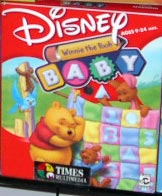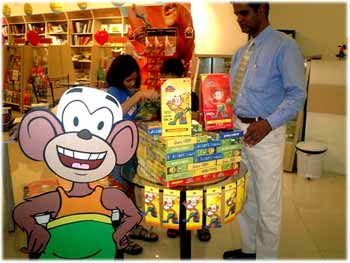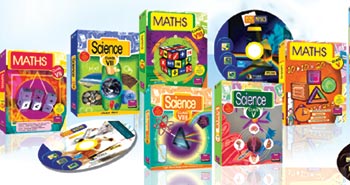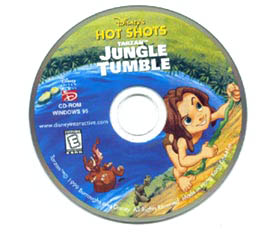Times Multimedia’s affair with animation began 5 years back in ’99, when it became the exclusive distributor for Disney Interactive in India and South East Asia. The publisher entered the market with 30 high end CD ROM titles priced at a precious 1760/- per title. Back then, the content was mostly edutainment based.
 Today, the multimedia major has around 600 titles in the interactive segment which includes edutainment content, games and simulation aided education. The price range is more consumer friendly beginning at Rs.150/ for side-scroll games going up to Rs.2000/ for premium fare. Additionally, the multimedia major has also forayed into home entertainment with 4 titles already on the racks. The content, being planned in multiple languages at various price points is now available at 300 topline stores across the country.
Today, the multimedia major has around 600 titles in the interactive segment which includes edutainment content, games and simulation aided education. The price range is more consumer friendly beginning at Rs.150/ for side-scroll games going up to Rs.2000/ for premium fare. Additionally, the multimedia major has also forayed into home entertainment with 4 titles already on the racks. The content, being planned in multiple languages at various price points is now available at 300 topline stores across the country.
Looking forward, by April 2005, TimesMM plans to have around 40 VCD titles on the racks. It is also looking at aggressively marketing its simulation aided education range in the next year. Having established its presence at all the A category centers and some B category ones, the publisher now aims to expand its reach to all the B and C category centers in India. The decision to expand the reach is aided by the fact that the hardware (PC and/or VCD Player) penetration in the country has increased substantially over the past few years.
That, in a nutshell, is a summary of how the going has been for this player and what its outlook is for the future. Let us now delve deeper and focus specifically into the processes that are part of this business.
CONTENT

Times Multimedia is the exclusive distributor for Disney Interactive in India. It has a similar agreement with Israel based Compedia, which is a major developer of edutainment titles.
These agreements apart, most of the content that the multimedia major looks to publish is India centric. To quote the Times spokesperson, “We are looking at content which has an Indian connotation targeted at today’s kid with flavors that the kid understands.”
The spokesperson further adds,”We go back and get into the kid’s shoes and think, what is it that the kid is exposed to today? in his vicinity, in his school, at home, etc. etc. We go back and talk to that kid in his own language and at the same time give him the content that he relates well to.”
home entertainment

“Our strategy for content is to develop a lot of products which have a great script sense with the potential to sell a lot. The best part of being able to make a VCD is that we can make small stories and start developing a character. We can begin with 1 product gradually making 5-8 products. Over a longer period of time, the possibility of turning that character into a big brand is the goal. We are also looking at developing content with TV formats in mind.” Said the spokesperson.
Most of the animation work currently being done in India is service oriented, the production is mostly of foreign characters, sensibilities and storylines. If and when India-Centric content is produced, the makers choose to play safe and invest in the public domain stories. Times too, for the time being, has entered the home entertainment range with public domain stories. Early this year, the publisher tied up with Pune based Phoebus Creations and they have come out with titles on the Panchatantra, Jataka Tales and Aesop’s Fables. Additionally they have also published Toonz Animation India’s Tenali Raman for the Indian market.
Defending the rationale behind developing content based on public domain stories and also emphasizing on the innovations added, the spokesperson says, “When we decided that we wanted to get into the home entertainment market we made a conscious decision to do Indian content. We have started off from stories from the Public Domain. The TG is the kid but it’s the parent or grandparent that makes the purchase. Nowadays, children have 24 hr access to western animated fare on TV, parents/grandparents want to expose their children to Indian based content too.”

Further continuing, the spokesperson said,”To bridge the gap between ancient folklore and today’s generation, we have added characters and mascots like Monki the Monkey which is a very impish and naughty character which kids could relate to. He does all kinds of naughty things, he could throw a banana peel and later on, slip over it and pop up back saying, WHAT YOU DO COMES BACK TO YOU!”
“Monki is an integral part of the content we will be doing now, he is the companion character which will connect the story to the kids”
Talking about languages that the content is being developed in, the spokesperson pointed out that, “Besides Hindi and English, we are looking at making our content available in Tamil, Malyalam and Gujrati too”.
The decision to include Gujrati seems to be interesting. In other entertainment categories like TV, the south Indian market is a completely separate demographic which is well catered to, but there isn’t much TV in the Gujrati language.
On being asked to elaborate on the Gujrat angle, the spokesperson pointed out, “The Gujrati community is a very affluent one, it’s a community which is aware and open to new technology. Also it is one state in India which is not confined to one city, as in the entire belt is prosperous. How do we tap them? The answer is Gujrati content. We are looking for Gujrati voice artists and by December, the Gujrati version will be out. We are talking to a lot of people who have expertise in developing content in Gujrat and soon we should be coming out with some new products too”.
games

The game titles that Times offers are priced at a consumer friendly Rs150/. The games are mostly shooting and racing based games. “In India the most popular games are racing and shooting based, that’s what most kids ask for out here. The games which we first introduced were side scroll games based on these universal themes” says the spokesperson.
Looking at the next level, the multimedia major is currently developing a strategy game titled Real Cricket. Commenting on the game, the spokesperson says, “We are now developing a game on Cricket, titled Real Cricket, It would be the first time that an Indian publisher would be developing a game on its own engine. The game is unique in the sense that it has pause play systems where the focus is on making the players understand things like ball trajectory and field placements. The game launches November.”
In the edutainment segment, Times is pleased with the response it is getting with the Disney and Compedia titles. Disney’s Pooh baby is the highest selling title and targeted at toddlers (would you believe it!). “The game is positioned as the ideal baby sitter, though it is alternately a good activity for parents to indulge in along with their babies too” says the spokesperson.
Times has launched a new series based on various MindGames in association with Compedia. The games emulate brain teasers like Brainvita which have been adapted to the CD ROM mode.
simulation aided education

Another interesting category that Times is looking to tap in a major way is Simulation aided education. For this it is working closely with Bangalore based Edurite Technology. The series titled 24hr Teacher is different from edutainment in the sense that it is a direct approach wherein the subject is explained using the impactfull simulations.
“These are not simple, scan the textbook kind of products that we are talking about. Great research and extensive content goes into each title with each subject having 6-8 CDs. There are so many things in science and other subjects that can be explained much more effectively using animation. Chemical bonds, dissection of frogs and so on. We have had schools and principals coming in and buying the entire range.” Says the spokesperson.
“24hrTeacher has 2 TG’s, one is the Class IV to VIII group which is catered to as one band. Whether the student is ICSE, CBSE, SSC or any other board, the knowledge imparted to this TG is of common concepts such as inertia or oxidization or gravity. Going higher, the education begins to differ and so for class IX to the the higher ones, there are separate titles for each board and class” says the spokesperson.
THE CONSUMER
 “The fact that PC and VCD hardware penetration has gone up in India and even 4-5 yr. olds know how to play a CD on the PC helped us a lot. The market is now much more computer savvy and literate as compared to 4 years ago when we would have to literally explain and educate consumers on how to operate the CD.” shares the spokesperson.
“The fact that PC and VCD hardware penetration has gone up in India and even 4-5 yr. olds know how to play a CD on the PC helped us a lot. The market is now much more computer savvy and literate as compared to 4 years ago when we would have to literally explain and educate consumers on how to operate the CD.” shares the spokesperson.
The TG varies across categories. While Games are an addiction for the 12 -21 age group,the edutainment titles are targeted at toddlers, preschoolers, and primary education kids.

The education titles, are obviously targeted at secondary, higher secondary and college students. The home entertainment fare has a slightly more expanded TG as compared to edutainment, though a major chunk of consumers are kids.
“For the Home entertainment category the TG is the kid but it is the parent or grandparent that makes the purchase. Today children have 24 hour access to western animated fare on TV, parents/grandparents want to expose their children to Indian based content too. In a smaller town we are looking at a parent who may not speak English but buys the English version so as to provide his children with the same” points out the spokesperson.
“The typical consumer for our products is someone who is aware of the content, is computer savvy, is discerning and wants the best” says the spokesperson.
Out of the total consumption, 70% is Urban while 30% is small towns and semi urban.
Sharing another interesting snippet about consumer behavior, the spokesperson said, “You know where we sell my mini CDs out? from the cash tell point. That’s exactly where I have it, so this is around 150 or 199 and while the consumer is billing at the cash tell point, he finds the thing interesting and picks it up”
PROMOTIONS & POSITIONING

“We see to it that we go all out to promote each and every of our brands aggressively. All the communication is completely away-technology, we always talk about the user friendliness, the product itself and the fun element. We don’t talk about the technology”Says the spokesperson.
Given TimesMM’s parentage, it has a distinct advantage as far as promotional opportunities are concerned and is in a position to exploit it fully.
“We frequently have the Disney people telling us about how their consumer products division constantly benefits from the promotions we do for the Disney interactive content. When we started out, making Disney larger then Pooh or Mickey was what our entire efforts were focused on. There are so many new characters that have come in and we wanted to exploit the potential of each.” Says the spokesperson.
Further continuing the spokesperson adds, “Toy Story II was a great success for us. We tied up with Columbia Tristar and did the promotions around the movie. We offered 4 tickets to the movie along with a CD-ROM purchase and we had special screenings where 700 kids would watch the movie. The value addition was so high to a consumer there.”
TimesMM has also adopted the practice of posting sales promoters at topline stores. “We have trained sales promoters. These are young kids studying in college and doing part time with us. The promoter has a computer there, where he demonstrates and explains to every single individual as to what the product is going to do for him” Says the spokesperson.
“If we are looking at a high priced item where the consumer is shelling out an x amount of money today, then the consumer wants to and has the right to know what he is getting for his money. The sales promoter does that for him”

Amongst other activities, the publisher organizes story telling sessions, voicing demos and painting competitions for kids.
Sharing an interesting experience, the spokesperson said, “Another interesting activity we did was demonstrating the voicing process to kids. An animation played in the background even as Tom Alter and the other people who had actually done the voices, demonstrated it live for the kids. The kids too tried it out. It was a fun session which the kids enjoyed even as they sampled our product”
DISTRIBUTION & REACH

“We operate out of 300 topline retail stores across the country. We also have a small percentage of business coming in from mail orders”
Talking about the way in which it has classified its outlets, the spokesperson shared,” In ‘A’ category we have all the super malls where we stock all our goods and in most cases our high end products do well out here. A PremSons and Lifestyle come in that category. A Big Bazaar too is an ‘A’ category outlet for us because of the huge number of walk-ins and the volumes it does for us. Yet we would retail to the budget consumer there. B category would be smaller sized stores, where we stock our budget games and lower priced products”
Talking about the way in which the market is divided across India, the spokesperson pointed out that while Delhi and Chennai were good consumers of simulation aided education, Maharashtra (Mumbai/Pune/Nagpur) was a big market for edutainment, while east (Kolkata/Guwhati) was a budget place where the budget games and general knowledge did well. Bangalore, remarked the spokesperson, was a complete revelation, where their complete product range across different price points and genres was doing well.
“Bangalore being the IT hub of the country, the consumption of CD ROM based edutainment and entertainment is much higher and so are the disposable incomes” added the spokesperson.
Besides the malls, the content is also available via mail orders. A lot of people from small towns where the fare is not yet available, mail in the orders. “You would be surprised to see the kind of enthusiastic responses we get from the Jabalpurs and the Bihars of the world” said the spokesperson.
“There is also a convenience associated with mail orders where the product is delivered at the consumer’s doorstep. Other than the mail order service, we have door delivery facilities from some of our outlets in Mumbai, Bangalore and Delhi” remarked the spokesperson.
Talking about extending reach, the spokesperson said, “We are trying to move into more ‘B’ towns and also enter ‘C’ towns. For the same we are expanding our product catalogue on the regional languages and are looking more at products like the VCDs for which the player hardware penetration is higher. We are also looking at coming up with low priced products in the sub 199/- category.”
“We may not want to look at the store level penetration, we would really want to be available at every single town where we see that there is PC penetration or VCD Player penetration today” remarked the spokesperson.
When asked as to why not enter smaller stores too, and multiply reach from 300 to 1000, the spokesperson replied “We can’t go into a small store today, reason being that the individual who is walking into a store like that does not have sufficient exposure to a product like this. A product category like ours needs a lot of education even today. The consumer needs to know what the product is all about, where does it play? what is the content? Things like these need a lot of display, they need a lot of touch feel, the inducement has to happen and most of times in the lower priced category it is the impulse that makes you buy the product. When we go back to a smaller store right now, such displays are not practical nor are they viable”
“On the other hand, tomorrow we may just go in an In and Out store like the Bharat Petroleum store. Again the logic here would be that the TG is people who are car owners” added the spokesperson.

PRICING
The price points that Times entered with, were high end. In its quest for volumes, the publisher realized that India is a price sensitive market. It felt the need to reconstruct the product range vis a vis price points. Today it is even considering price points which are sub Rs.199.
While high end premium content is a careful buying decision made by parents, the low end range has kids reaching for their pockets and buying on impulse.
“Our first products, which were Disney titles, were priced at Rs.1760. India is a very price sensitive market and in our efforts to seek volumes, we realized we needed to rework our products to suit the price sensitive market. We discussed this with Disney and came up with a special product called Disney Mini which was a credit card sized CD packed with high quality Disney content and priced at Rs.199. This product was exclusively developed for India. It helped us break open many barriers in the market. We promoted and positioned it as an impulse purchase product.
Talking about the budget games series, the spokesperson elaborated,”India doesn’t have a big gaming community as such, and we are still looking at a lot of first time users coming and buying a game. If we would have introduced games from a developer like an Activision or an E.A., our prices would be somewhere in the range of Rs.1299 and the volumes would’nt come in. We decided on getting into entry level games and launched our titles at Rs.150”
The TG for the home entertainment range includes a lot of consumers who may not be necessarily having PCs. TimesMM has so far treaded this segment at the safe price of Rs.199 and is actually looking at some titles for the regional markets which could be priced even lesser.
PACKAGING

To the experienced marketer, packaging is a critical issue. It can kill or enhance a product’s appeal. And nothing that doesn’t look appealing can ever sell.
“Packaging is something we invest a lot of money and time on. We research along with our agency origin beanstalk and come up with designs that sell” remarked the spokesperson.
Further adding, “There is a complete fight happening for shelf space everywhere today, so for that shelf space that you get are you being completely visible, vis a vis the counterpart who’s also selling across there, and also vis a vis your own other products which you have there. How do you make your product attractive to a kid to a parent to come and pick it up and walk out.”
“A whole lot of these chain stores, do not allow POS’. So our box works as our packaging as well as our POS.”
PIRACY
Piracy is killing the world’s music industry. Does the easy availability of pirated games affect TimesMM too?
“We are not greatly affected by piracy, though it is a menace and all measures should be taken to curb it. What needs to be understood is that the mindset of a consumer who buys a branded interactive CD-ROM is different. Firstly, an edutainment product is bought by a consumer who wishes to add value to his/her child’s education or upbringing. The packaging, the quality and over all, our consumer friendly prices, make it a clear choice for him to opt for a branded product, rather than pick up cheap imitations from the wayside which would’nt serve the purpose of adding value” said the spokesperson.
Further explaining, “In games there could have been a dent, but again our competitve pricing of Rs.150. makes the gap too small for our consumer to opt for pirated filth. The same applies for the home entertainment content.”
——————————————————————————
Concluding the study for now, one can take home some lessons which though oft repeated, are so important that it is worthwhile repeating them.
– India has a small yet significant consumption of content featuring animation in the home and interactive segments. At times, animation is the core, at times a part.
– There is a substantial amount of consumers in non urban centers. These consumers are aspirational, they wish to provide their kids with the best. At times such consumers are more prolific buyers than the average urban consumer.
– India centric content can help break the clutter amongst a majority of foreign fare
– India was and is a price sensitive market.
– Intelligent packaging focussed at the TG is essential to sales, especially in such a segment. Bad or confused packaging could mean dead stock.
– Piracy does not pose a big threat to this category of products, because the mindset of the TG is different from that of those who usually pick up pirated stuff.
(Images courtesy – Times Multimedia, www.timesmultimedia.com, www.wisprovupdates.org and Animation ‘xpress art dept.)

